These simple, yet over-the-top flavourful Dominican Habichuelas Guisadas are beautifully luxe, tender, and creamy. A bowl of these beans will keep you happily nourished and satisfied ~ feel good food at its finest!
To me, Dominican stewed beans are the ultimate comfort food from my childhood. It is a food charged with memory and longing that evokes hominess and a feeling of well-being like no other. Habichuelas guisadas, beans that have been stewed until tender then flavoured with onions, green pepper, garlic, and spices, is a dish made from humble ingredients yet deliciously luxurious and satisfying. These creamy beans swimming in their cooking liquid are so rich in flavour and substance, they can stand in for a fantastic main meal. I may be biased, but I think you will love them as much as I do.
Though they may follow a basic principle, no two recipes for habichuelas guisadas are the same. The sofrito in particular, which is a mix of aromatics and herbs that form the foundation of most Latin American stews, soups and braises, will vary greatly. Not only between countries, but from household to household.
Like most dishes from my childhood, this one took years for me to get right. I knew I had finally made a version that was authentic to me when I didn’t have to taste it. I knew just from the smell it would be as delicious as I remembered it.
Best beans to make habichuelas guisadas
Dry vs canned:
Let’s get this one right out of the way, shall we? Listen, I could write an entire post on why dried beans are worth the effort. But if you cringe at the thought of tackling dry beans and there is no way to convince you, then go ahead and use canned. I make lovely delicious beans from cans all the time. Know, however, that for this particular recipe, it is almost essential to use dried beans. The magic of these habichuelas guisadas is the deeply-flavoured, creamy, almost soupy, broth you get from cooking dried beans. You will never, ever be able to get that out of a can.
Type of beans:
Dry pinto beans are my choice of beans to make these habichuelas guisadas. They can be found in most well-stocked supermarkets and they are super creamy and delicious. Cranberry beans (also known as Romano), pink beans, or small red beans can also be used. Many recipes call for red kidney beans to make these habichuelas guisadas. Please use these as a very last resort. Kidney beans are just not very creamy, or flavourful, and have a thicker skin. If you find beans labelled “light red kidney beans” which have a softer skin, and creamier interior, go ahead and use those.
TIP: Buy beans from a place that has a good turnover. Beans that have been sitting around or stored for years, will remain tough and not soften even after hours of cooking.
What you’ll need to make the best Dominican habichuelas guisadas
Once you have your bean variety sorted out, the rest of the ingredients could not be simpler. Use this recipe as your base, then feel free to tinker with it as you please. Add more water for brothier beans, blend the beans for a thicker sauce, or add other favourite spices, to name just a few variations.
- Dry beans: Velvety, creamy, and thin skinned, pinto beans are my favourite. (See above for more choices.)
- Onion, garlic, and green pepper: This trifecta forms the base of the sofrito. I prefer to use red onions, but you can use whatever you have on hand. I like my sofrito base particularly pungent so I add a lot of garlic. You can use a cubanelle pepper if you find it, but I quite like the regular green bell pepper for these beans.
- Bouillon cube: This is optional but it does add and extra little boost of flavours. You can use chicken or vegetable just be sure it is low-sodium.
- Tomato paste: To add some colour and deepen the flavour of the sauce.
- Cilantro: Culantro, not cilantro, is more commonly used to flavour habichuelas guisadas. It is a robustly-flavoured green herb that is widely used in the Caribbean to flavour beans, soups, and other dishes. Culantro, also known as recao, has a similar aroma and taste to cilantro and is hard to find outside Latin American countries. Cilantro is a suitable substitute for most dishes, including these beans. I like to season my beans with a generous amount of cilantro, not just a few sprigs, while they cook.
- Squash: An astonishing fact, even to me, is that squash, along with beans and corn, is a Latin staple plant. It is one of the few crops that grows as happily in the sweltering heat of the tropics as in the chilled soils of Canada. In the Dominican Republic calabaza (pumpkin squash) is commonly used to thicken the bean broth. I use kabocha squash but I know they can be a pain to cut and peel. You can easily buy the fresh, pre-peeled (or frozen) bags of any squash if you don’t feel like dealing with cutting and peeling your own. Alternatively, you can skip the squash (but please don’t) and simply blend a cup-full of beans to thicken the sauce. Tip: Store uncut squashes in a cool dry place, not the refrigerator. Once cut, keep the squash wrapped in the refrigerator.
- Kosher salt and freshly cracked black pepper: These beans can take a lot of salt but you will have to taste and adjust as you go since not all beans are the same.
Note: Notoriously absent from this list of ingredients is adobo seasoning — the classic spice mixture that has come to be a staple in kitchens across Latin America. Adobo seasonings come in powdered, or paste, form and undoubtedly add incredible flavour to whatever you add it to. The problem with these seasonings, aside from being hard to find for those not living anywhere near a Latin American store, is that most contain MSG and other food dyes that I try and avoid as much as possible. If you happen to have a jar in your pantry, feel free to go ahead and add a few dashes to the pot of beans. Otherwise, there are plenty of other fresh ingredients in these beans that add fantastic flavour and colour so you won’t miss the adobo.
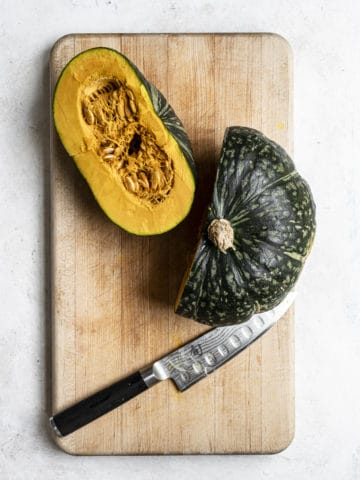
To soak or not soak the beans
This debate may never be settled in my lifetime. Here’s my two cents.
Soaking your beans helps them cook faster and more evenly, and it can also make them easier to digest. However, the age, quality, and variety of the bean can determine whether a long soak is necessary or not. When cooking thinner-skinned beans such as black beans, I tend to skip the overnight soak. Slightly thicker-skinned beans such as pinto, in general, will benefit from an overnight soak. Especially if you are uncertain of their quality and age, a long soak will offer extra insurance.
Here are the different methods for soaking beans:
-
OVERNIGHT SOAKING
Place rinsed and drained beans in a large pot and cover with water by 3 inches and add 1 tablespoon kosher salt (or 1 tablespoon fine salt) per pound of beans. Let them soak for at least 6 hours or overnight. Do not soak for longer than 24 hours.
-
QUICK SOAKING
Quick-soaking is a great option if, like me, you forget to plan ahead. Place the rinsed and drained beans in a large pot on the stove, cover with water by 3 inches and bring to a rolling boil. Turn off the heat and let them soak for an hour. Proceed with the recipe.
-
SKIP THE SOAK
Beans can be perfectly cooked without soaking. Just make sure you are using the freshest beans possible and plan on potentially cooking them for longer than a recipe calls for. If the beans are getting too dry, simply add more water as needed.
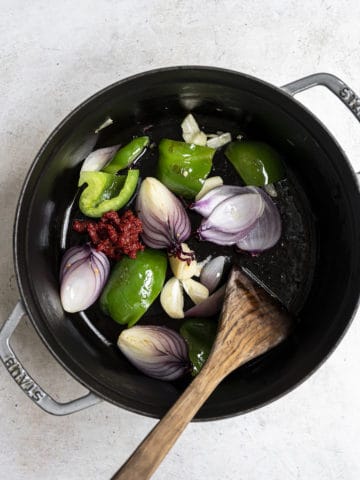
How to cook and soften beans
I love nothing more than a big, rich, hearty pot of beans bubbling away on the stovetop for a couple hours while I go about my business. Unfortunately, the age and source of the beans will inevitably create some unpredictability for the cooking time needed to soften any beans.
An Instant Pot is a fantastic way to by-pass this issue. I recently cooked expired beans in the Instant Pot that turned out perfectly soft in only 20 minutes of pressure time. If I had attempted to cook them on the stovetop, I am quite certain I would have been giving up after 4-5 hours with nothing but hard beans to show for it. I do prefer to use the Instant Pot but I realize not everyone has one so for this recipe I provide instructions for the stovetop as well.
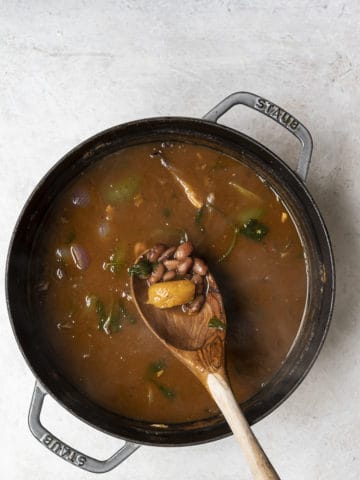
How to make Dominican habichuelas guisadas
Once you have tender cooked beans, making these habichuelas guisadas is an absolute cinch to prepare and throw together.
INSTANT POT METHOD
- Place the rinsed and drained beans, salt and 1 bay leaf in the Instant Pot. Add 5 cups of water, close the lid, set the valve to “seal”. Pressure cook on high for 20 minutes. When finished, allow to natural release for at least ten minutes, 15 minutes is best, then carefully finish with quick release. Soaked beans will cook more quickly than unsoaked beans so if you used soak beans, reduce the time by 5 minutes.
- While the pressure is releasing, heat a few tablespoons olive oil in a large heavy-bottomed pot over medium heat. Add chopped onion, green pepper, garlic and spices and sauté until slightly softened. Add the tomato paste, salt and pepper, and bouillon cube, if using. Sauté another 2 minutes then add the softened beans and liquid from the instant pot, plus 2 more cups of water, to the pot with sautéed vegetables.
- Add the squash and bring to a gentle boil.
- Lower heat and boil gently, uncovered over medium-low heat until the broth thickens and becomes creamy, about 25-30 minutes. Taste and add more salt and pepper to taste. If the liquid is not thick enough, mash a few beans on the side of the pot, stir well, and cook for an additional few minutes. The liquid should be creamy and the consistency of a stew — not super thick but not too thin.
- *Before serving, pick out and discard the bay leaf and the cooked chuncks of onion and green pepper.
Note: I realize you could just as easily finish making the habichuelas guisadas in the Instant Pot using the Saute function, as opposed to transferring the beans to another pot. Either way, you are dirtying another pan (you need to saute the vegetables) and I find it easier to control the heat on the stovetop.
STOVETOP METHOD
- Pick over the beans for small rocks or debris and discard any that are damaged or discoloured. Rinse well and drain.
- Place the beans in a large heavy-bottomed pot and cover with at least 3 inches of water. (If you soaked the beans, do not drain and add more water if needed). Bring to a gentle simmer stirring occasionally, checking to make sure they are always covered by at least 2 inches of water.
- Once the beans are soft, heat a few tablespoons olive oil in a small skillet over medium heat. Add chopped onion, green pepper, garlic and oregano and sauté until slightly softened. Add the tomato paste, salt and pepper, and bouillon cube, if using. Sauté another 2 minutes then add the mixture to the pot of now softened beans.
- Add 2 cups of water to the beans, along with the squash and cilantro sprigs and bring to a gentle boil.
- Lower heat and boil gently, uncovered over medium-low heat until the broth thickens and becomes creamy, about 25-30 minutes. Taste and add more salt and pepper to taste. If the broth is not thick enough, mash a few beans on the side of the pot, stir well, and cook for an additional few minutes. The liquid should be saucy and creamy — not super thick but not too thin.
- *Before serving, pick out and discard the bay leaf and the cooked chuncks of onion and green pepper.
*Most Dominicans do not like to find the large pieces of cooked onions and green peppers in their beans. Chop them smaller and leave them in, if you wish.
How to serve Dominican habichuelas guisadas
You can enjoy these beans as is, topped with avocado slices and a little drizzle of olive oil. Or use them to top thick slices of garlicky toasted bread – yum!
We also love these habichuelas guisadas for lunch tucked into tortillas that have been slathered with mashed avocado and nothing more. But mostly, we enjoy these beans heaped on top of white fluffy rice, alongside stewed chicken, plantains, and a green salad in authentic Dominican-style. Divine.
Other Dominican recipes you might enjoy
- Moro de Habichuelas Negras (One-Pot Rice and Beans
- Albondigas Guisadas (Stewed Meatballs)
- Arroz con Pollo (One-Pot Chicken and Rice)Print Recipe Pin Recipe
Dominican Habichuelas Guisadas (Stewed Beans)
These simple, yet over-the-top flavourful Dominican Habichuelas Guisadas are beautifully luxe, tender, and creamy. A bowl of these beans will keep you happily nourished and satisfied ~ feel good food at its finest! If you don't own an Instant Pot, I have included stovetop instructions in the recipe notes.Ingredients
- 1 lb dried red kidney beans
- 1 bay leaf
- 3 teaspoons kosher salt, divided or more to taste
- 2 tablespoons olive oil
- 1 red onion cut into wedges
- 1 bell green pepper cut in 6 pieces (or cubanelle pepper)
- 4 cloves garlic peeled and crushed
- 1 teaspoon dried oregano
- 2 tablespoons tomato paste
- 1 chicken or vegetable bouillon cube low sodium
- freshly cracked black pepper to taste
- 3/4 - 1 pound squash such as kabocha, pumpkin or butternut peeled and cut into 2-inch pieces
- a handful of cilantro sprigs
- 2 teaspoons white vinegar optional
Optional for serving
- white rice
- avocado slices
- chopped cilantro leaves
Instructions
- Pick over the beans for small rocks or debris and discard any that are damaged or discoloured. Rinse well and drain.
- Place the rinsed beans, 1 teaspoon salt, and 1 bay leaf in the Instant Pot. Add 5 cups of water, close the lid and set the valve to "seal". Pressure cook on high for 20 minutes. When finished, allow to natural release for at least ten minutes, and then carefully finish with quick release. Soaked beans will cook more quickly than unsoaked beans so if you used soaked beans, reduce the time by 5 minutes.
- While the pressure is releasing, heat 2 tablespoons olive oil in a large heavy-bottomed pot over medium heat. Add onion, green pepper, garlic, and oregano and sauté until slightly softened, about 4-5 minutes. Add the tomato paste, and bouillon cube, if using. Sauté another 2 minutes.
- Add the cooked beans and liquid from the Instant Pot to the pot with sautéed vegetables, along with 2 teaspoons salt, and freshly cracked black pepper to taste. Stir in the squash and cilantro sprigs and bring to a gentle boil.
- Continue to cook, uncovered, over medium heat until the broth thickens and becomes really creamy, about 25-30 minutes. Drizzle in the vinegar, if using. Taste and add more salt and pepper, if needed. If the liquid is not thick enough, mash a few beans on the side of the pot, stir well, and cook for an additional few minutes. The liquid should be creamy -- not super thick but not too thin.
- *Before serving, pick out and discard the bay leaf and the cooked chuncks of onion and green pepper. Serve warm with optional sides or toppings.
Notes
*Most Dominicans do not like to find the large pieces of cooked onions and green peppers in their beans. Chop them smaller and leave them in, if you wish. STOVETOP METHOD- Pick over the beans for small rocks or debris and discard any that are damaged or discoloured. Rinse well and drain.
- Place the beans in a large heavy-bottomed pot and cover with at least 3 inches of water. (If you soaked the beans, do not drain and add more water if needed). Bring to a gentle simmer stirring occasionally, checking to make sure they are always covered by at least 2 inches of water.
- Once the beans are soft, heat a few tablespoons olive oil in a small skillet over medium heat. Add chopped onion, green pepper, garlic and oregano and sauté until slightly softened. Add the tomato paste, salt and pepper, and bouillon cube, if using. Sauté another 2 minutes then add the mixture to the pot of now softened beans.
- Add 2 cups of water to the beans, along with the squash and cilantro sprigs and bring to a gentle boil.
- Lower heat and boil gently, uncovered over medium-low heat until the broth thickens and becomes creamy, about 25-30 minutes. Taste and add more salt and pepper to taste. If the broth is not thick enough, mash a few beans on the side of the pot, stir well, and cook for an additional few minutes. The liquid should be saucy and creamy -- not super thick but not too thin.
- *Before serving, pick out and discard the bay leaf and the cooked chuncks of onion and green pepper.
Tried this recipe?Tag @sandra_valvassori on Instagram or hashtag #sandravalvassori!


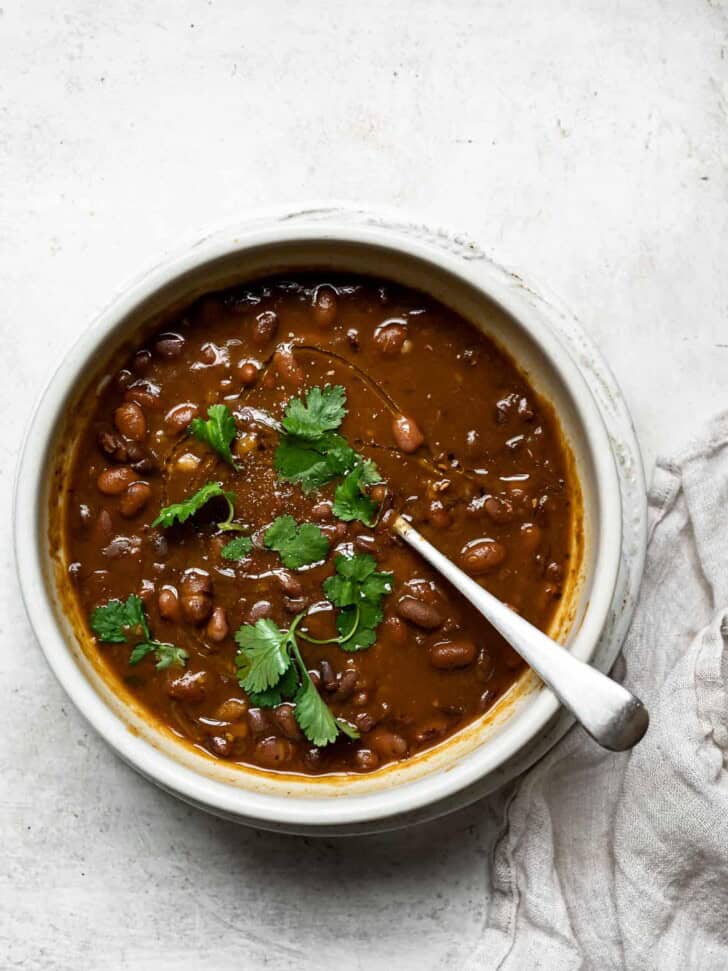
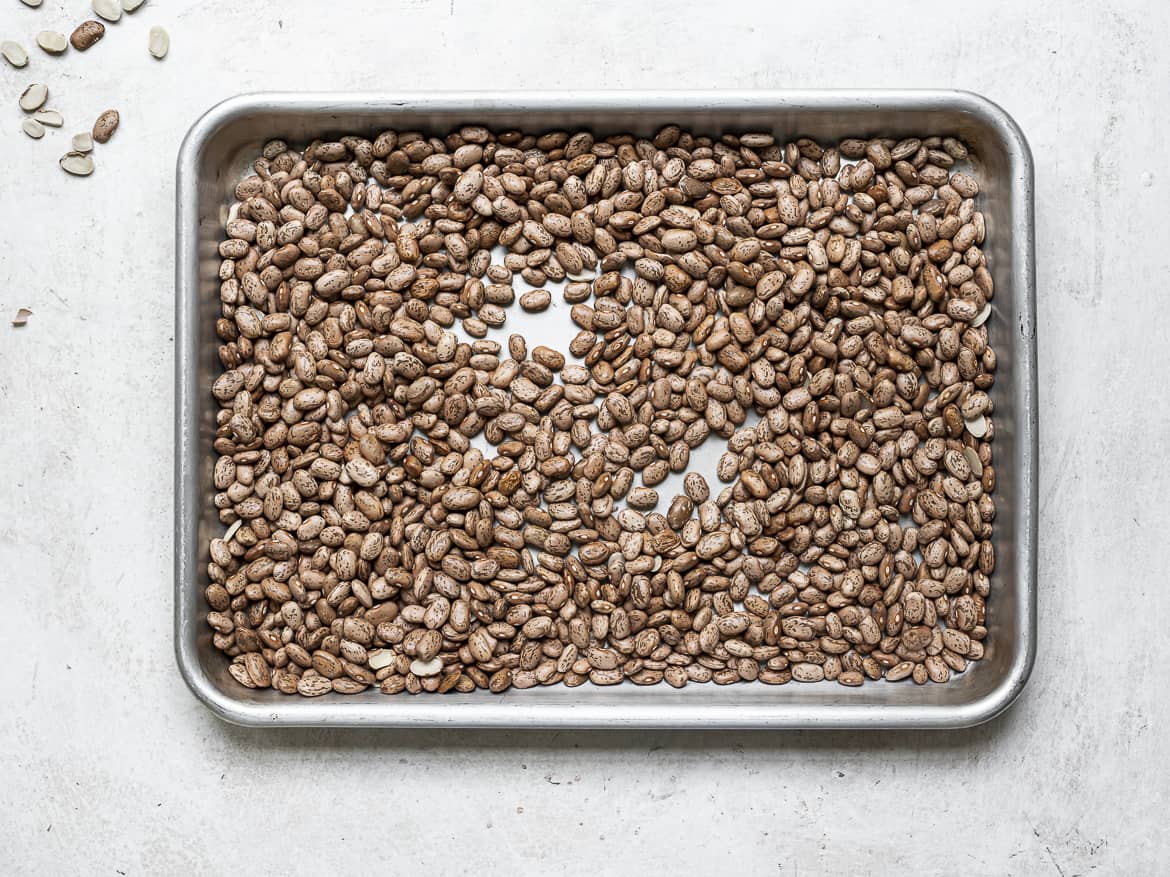
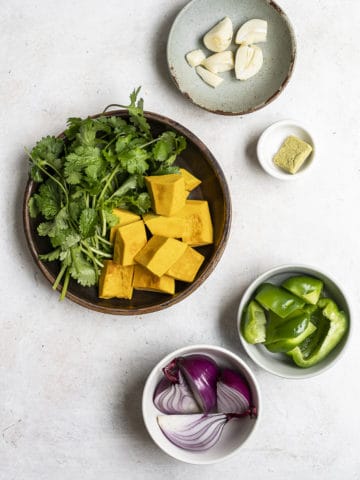
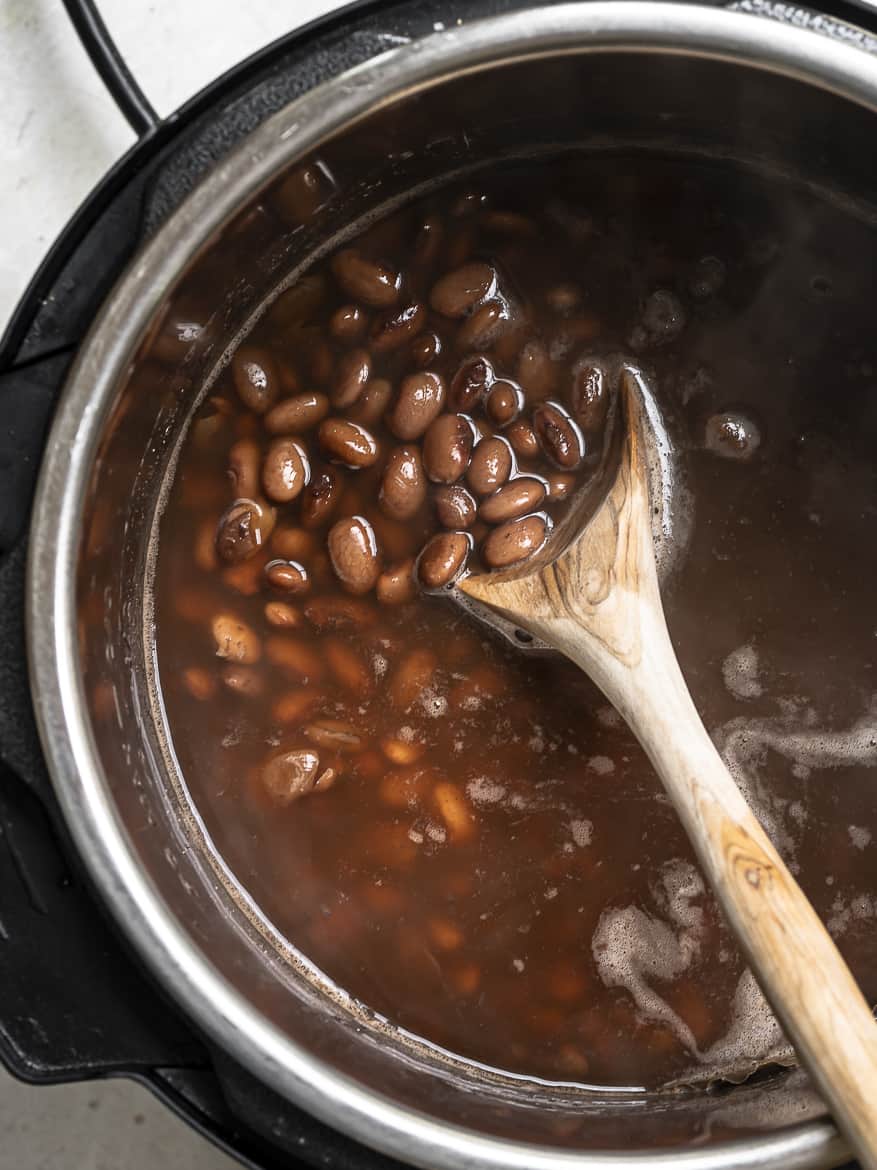
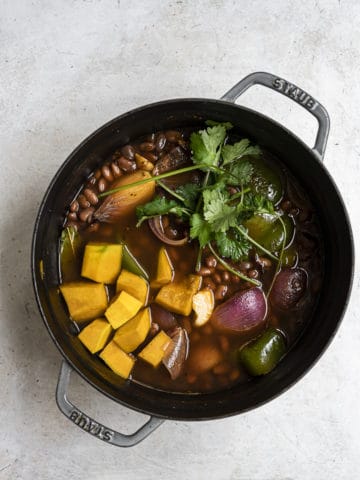
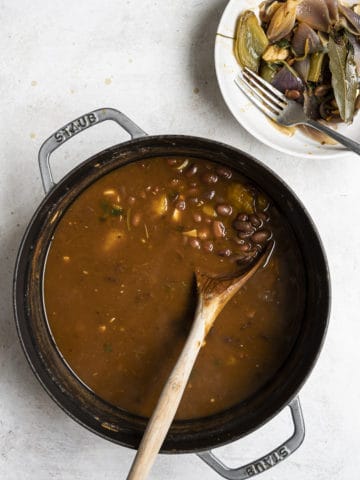
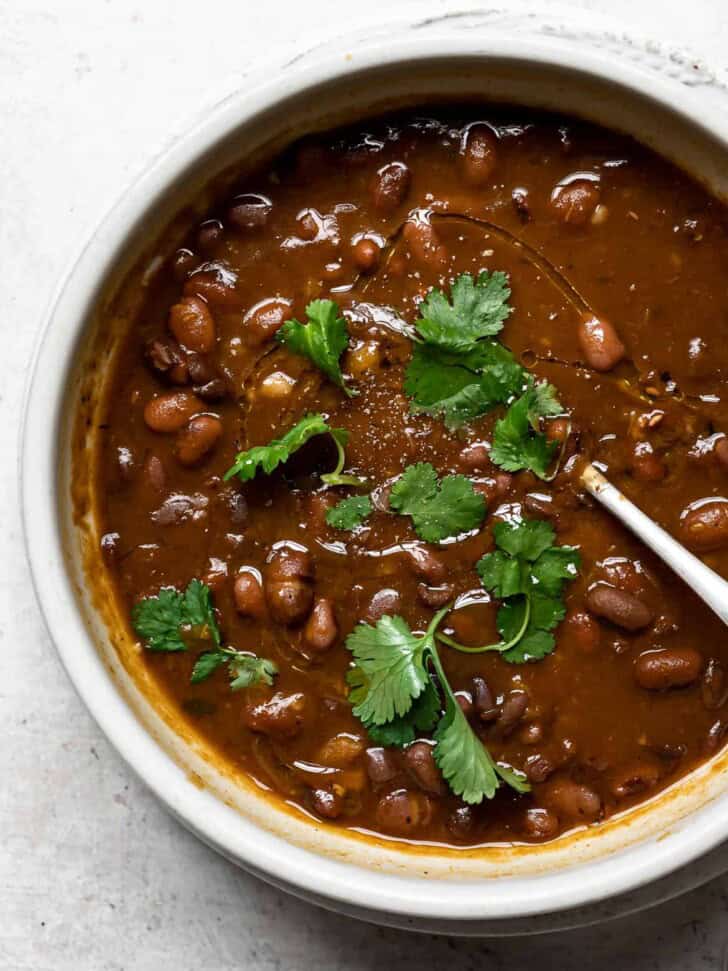
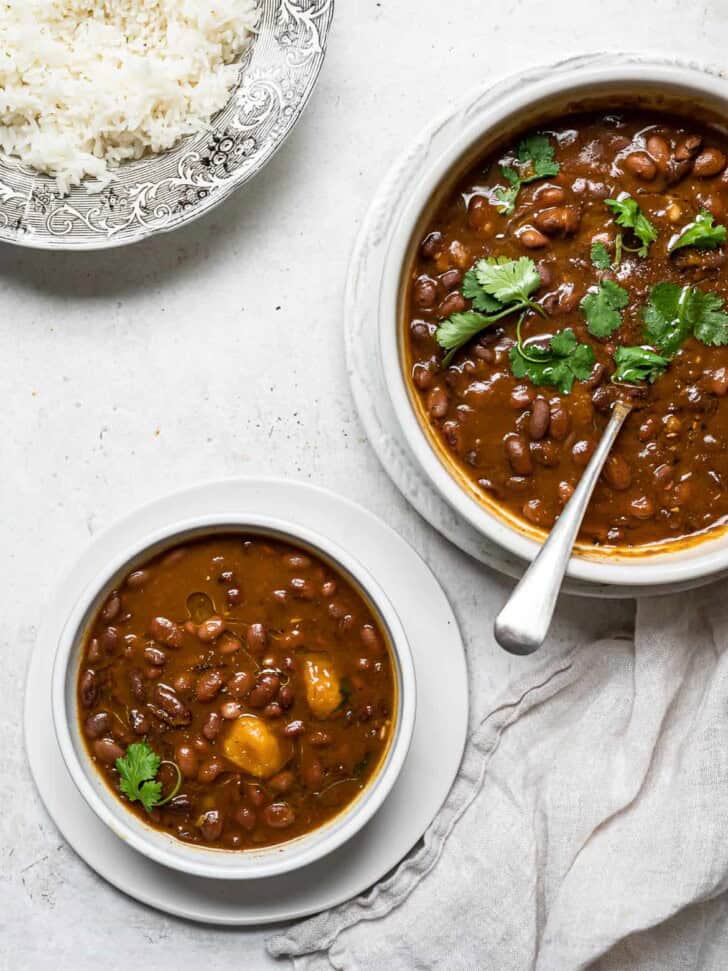
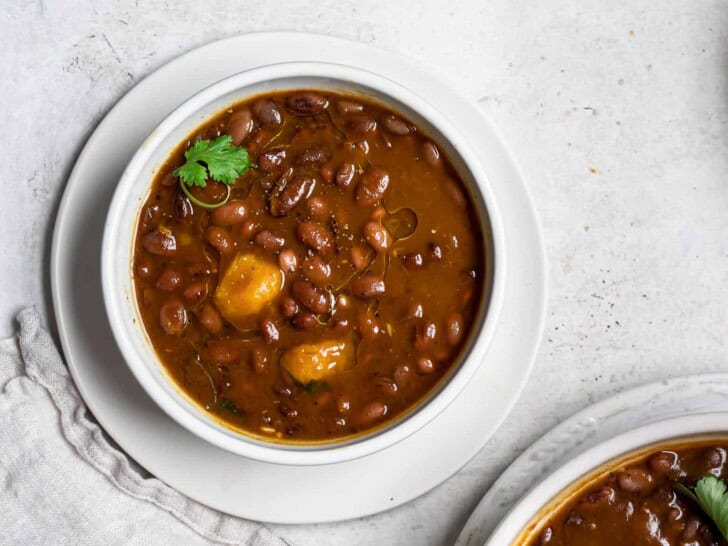
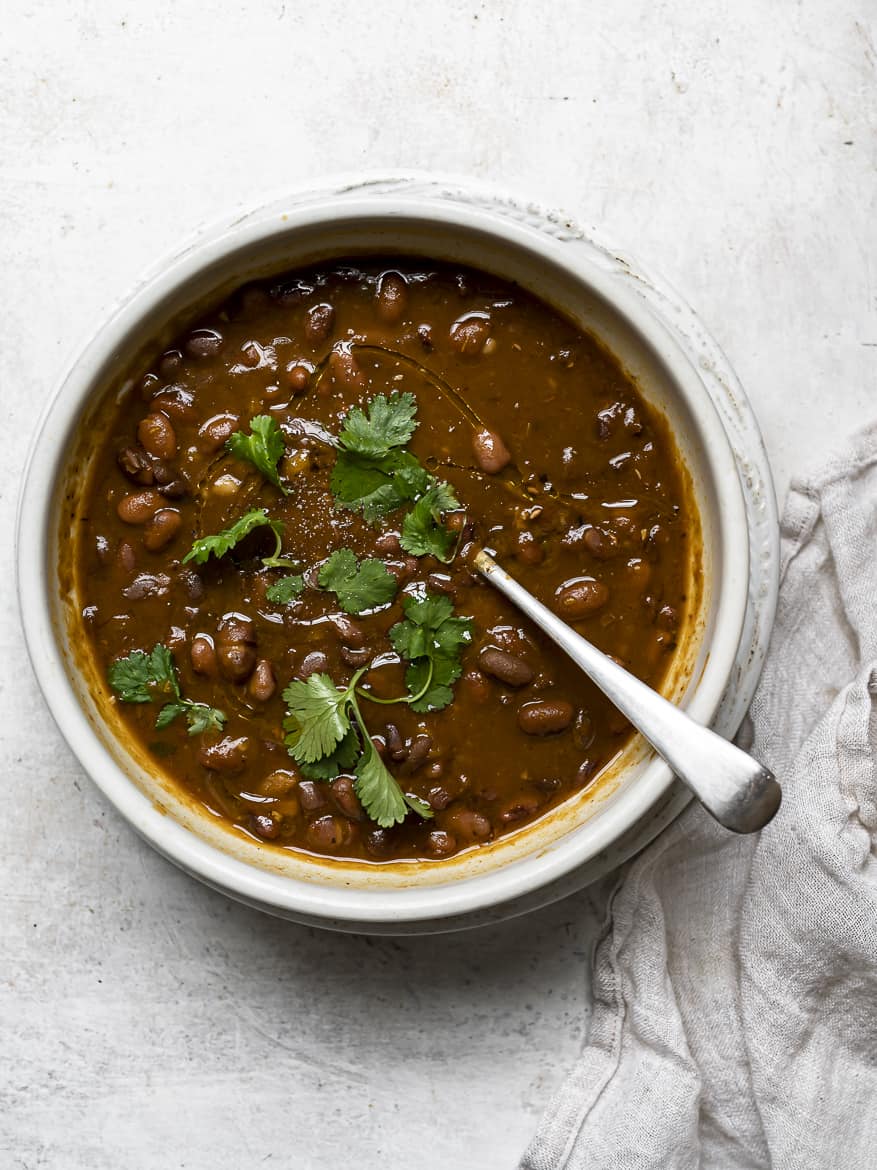
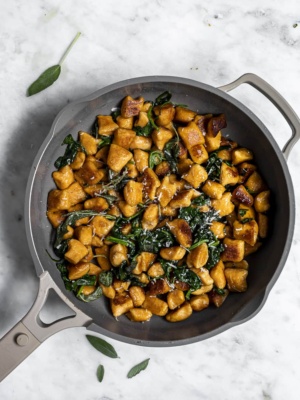
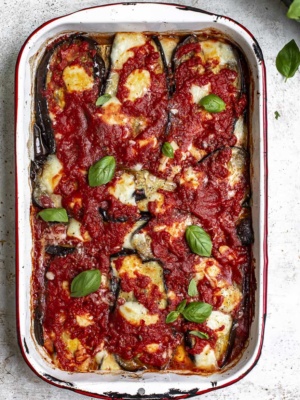

Linda P
I’m Albanian and recently married a Dominican. I’m so happy I found this recipe, it’s easy to follow and gives all the details needed to make these beans. My husband really enjoyed them and even compared them to his mothers! Thank you so much!!
Sandra Valvassori
Oh my goodness this message brought tears to my eyes! Many moons ago when I was recently married there was no internet for me to goggle my beloved Dominican recipes so I’m so happy this helped you and that your husband loved them. Thank you so much for sharing!
Elle T.
Great recipe! I just finished making this dish and its delicious! I made mine with pinto beans as that is what I had on hand. Im always looking for new bean recipes, consume a mostly vegan and vegetarian diet, and LOOOOVE cilantro. I also love Dominican food and have a great spot very close to me, as a resident of NYC. I did remove all of the large chunks of onion and green peppers as you instructed but as I didn’t want to be the least bit wasteful, I just puréed them, adding some of the beans as well to help with thickening the stew a bit, and mixed it all back into the pot. Because I have some black beans on hand, Im going to try out the Moro de Habichuelas Negras next and pair it with some soy chorizo. I’ll follow your instructions to a T regarding the rice in the dish. Thanks so much for your time and effort in posting and sharing!
Sandra Valvassori
Oh thank you so much for this wonderful comment! I’m so happy to hear you enjoyed the habichuelas gusiadas! Love that you pureed the onion and peppers and put them back into the beans. This makes for even greater consistency and flavour! Would love to hear back from you when you make the moro – the addition of soy chorizo sounds soooo good.
Frances
Really enjoyed this recipe, using black beans. However, confused about what to do with the squash chunks at the end. Mine didn’t disintegrate so we left them in. Was a nice texture change though I would cut them a bit smaller if that’s the intent. Should I remove and puree with the other veggies?
Sandra Valvassori
So happy to hear you enjoyed the beans, Frances! The squash does not need to be pureed. Mine does disintegrate quite a bit but if you look at the photos of the finished beans in the bowl, a few small squash chunks are still there. To be honest, I have never added squash when making black beans (though I don’t see why not?) so I’m not sure if that made a difference. If you prefer not to have some chunks of squash, you can absolutely chop them a lot smaller, or take them out and mash them up. Hope this helps and would love to know if you give them another try!
Deonte
I literally just made this using this recipe and I must say I got exactly what I was looking for. Delicious very rich in taste. Thank you.
Sandra Valvassori
So happy to hear this! Thank you so much for writing, and rating the recipe – very appreciated!